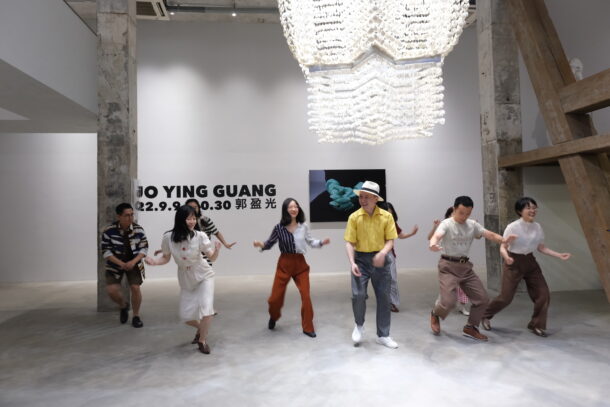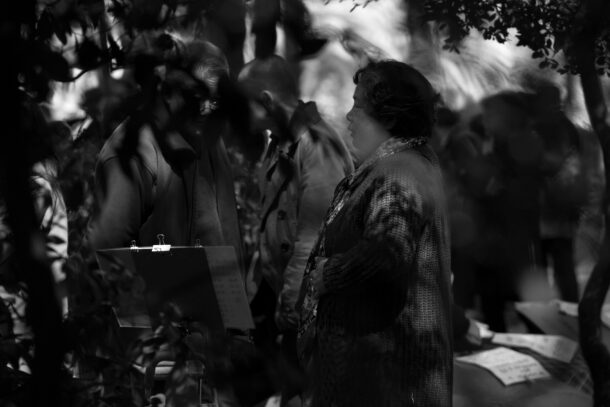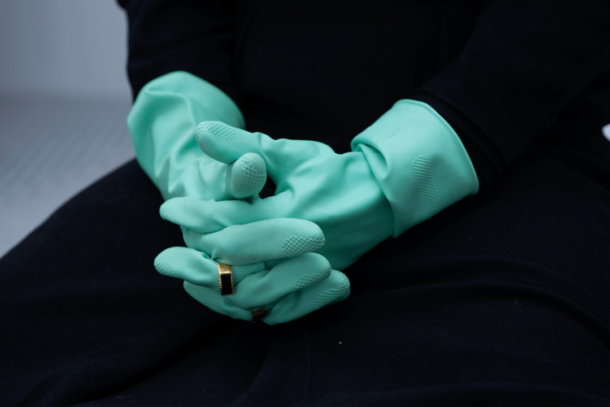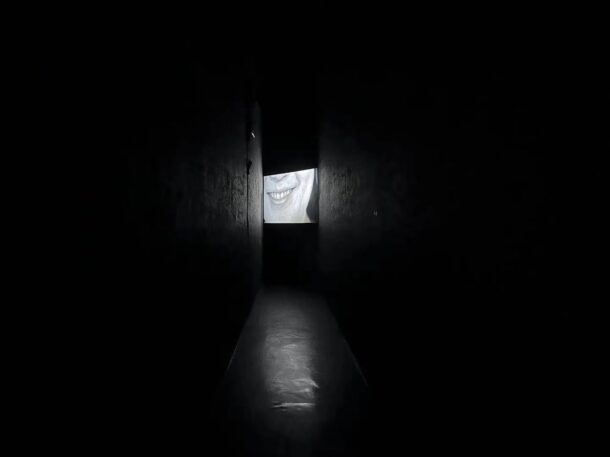Guo Yingguang, Alone and Together
| July 25, 2023
Three months have passed since Guo Yingguang performed swing dance at the opening of her eponymous solo exhibition. By then, Shanghai was drenched at the beginning of autumn, no eerie heat waves swirled or cold drafts crushed down; as Guo and her fellow dancers emerged in the murky indigo dusk, dressed in early-2000’s-inspired clothing, their whirling moves became almost the brightest part of the artist’s first solo exhibition since 2019. In retrospect, Guo’s artistic career has not been filled with such joyful moments.

On-site performance at the opening of “Guo Yingguang”, Brownie Project, Shanghai, 2022
Courtesy Brownie Project
Love Letter with an Expiration Date
By most, Guo Yingguang is best known for her iconic work, The Bliss of Conformity (2016—2017). In 2016, Guo was about to graduate from the University of the Arts London. This experience of studying abroad, a direct response to her “breakup,” has significantly transformed the journalistic mindset she developed while working as a photojournalist for China Daily and Reuters. During her master’s studies, she was covered from a professional journalist to an art student and artist, and was “dismantled bit by bit of her original structure” by her mentors and repeatedly impacted by the exchange of ideas with her fellow students abroad. Guo began to retrace her state of life growing up as a Chinese girl with traditional values after having departed from a long-term intimate relationship.
Whether out of the influences of a romantic relationship, family, or the societal values of “establish oneself by thirty” or “women should get married when old enough,” intimate relationships and marriage remained subjects that Guo Yingguang intended to clarify and examine at the time. After all, will marriage actually solve anyone’s life problems? If everyone got married at about the same stage of life, would they be happier than if they had rejected that choice? Perhaps, Chinese society, rooted in family and kinship, could be less conflicted because of such “obedience”?

Guo Vingguang, The Bliss of Conformity, 2016, archival pigment print, variable dimensions
Courtesy the artist
Guo Yingguang was motivated to explore these answers. She came to the matchmaking corner at People’s Park in Shanghai to “match” for herself—The Bliss of Conformity, a multi-media project combining performance, documentary video, photography, and an artist’s book, began with the artist’s unresolved confusion. But when she laid down her “conditions” and her preferences for a spouse on paper and placed it in a crowd of Shanghai aunties and uncles who were looking for a match for their children, what these wordings were to embody and penetrate was no longer happiness on a personal scale. Guo witnessed the Chinese parents in the corner of a verdant park, anxious and frowning about their children’s marriage and assimilated questioning, comments, and even judgments from others every day during the process. Among them, the analogy of “every house comes with a price” from an uncle spread in the artist’s various explanations of this work, becoming a classic: “If you are a woman, then it’s all about the house… How to be considered a good house? If you are young and have household residency registered in Shanghai, it means your house is located in a good neighborhood. You’ve got a real nicely furnished house; you’ve never been married; you are well-educated and pretty. But you are older and don’t have your residency registered in Shanghai. Your house is located outside the city, not in a good area.”
In terms of personal values, at least, the main focus of Guo Yingguang’s very series is “bliss,” which encompasses both external recognition as the realization of love (or marriage) and self-approval by extension; and the intertwined complexity of different social perspectives and identity interactions, thus, inevitably arises from the subdued confrontation between the artist and her research field. In the value hierarchy of marriage in Chinese society, the importance of “well-matched family background,” “talented men and beautiful women,” and “mutual love and affection” decreases, with the last criterion even being blamed in desperate situations. This societal grammar dictates that Guo’s pursuit of true happiness is almost destined to become a process that breeds self-doubt and even demands harm. Guo recorded the encounters and conversations with a body camera at the matchmaking corner. In the sixteen-minute video in her project, dozens of times, she repeats one phrase, “1983”—with a voice sweet yet not lacking in strength.
2016-收藏级艺术微喷-76x110cm-Ed-51AP-The-Bliss-of-Conformity-Untitled-5-2016-76x110cm-Archival-pigment-print-Ed-51AP-610x401.jpg)
Guo Yingguang, The Bliss of Conformity (Untitled 5), 2016, archival pigment print, 76 × 110 cm, Ed 5+1AP
Courtesy the artist
Even in 2016, for these anxious Chinese parents, the matchmaking corner at People’s Park was still in the pre-algorithmic era of matchmaking. The conversations among real people have revealed an overly blatant logic of “search and match” without the dating apps and matchmaking services supported by the so-called “big data and high-end customization,” and the prejudice and symbolic violence towards women become as pervasive and rampant as the summer heat and wild weeds in the park. Consequently, in her accompanying artist book of the eponymous project published in 2018, Guo Yingguang chose to render abstract images of the park’s natural environment using the technique of cliché verre; and when a red string is pulled out of a secret folder of waxed paper with botanical patterns, those seemingly extempore questioning and comments full of gender stereotypes become apparent.
At the matchmaking corner, in reality, papers with information about marriage candidates were threaded with red string, clamped with metal clips, and crumpled by fingers. These papers are also present in Guo Yingguang’s past exhibitions, often covering an entire wall. If they are considered as a social representation of women (or those arranged for marriage, regardless of gender), they may seem simplistic, yet they are abundant; they might be vulnerable but are actually full of resilience.
Between Soap and Steel Wire

Guo Yingguang, You Say You Like It Pale, 2022, single channel video, variable dimensions, Ed3+1AP
Courtesy the artist and Brownie Proiect
The Bliss of Conformity created a storm of public debate. Anonymous sent love letters to Guo Yingguang on social media, and young girls referred to her as an “idol, goddess”; some called her vicious for staging this collision, but others said she was a role model for feminists. Words have no countenance, yet they make those who receive them unconsciously change their appearance. Guo confesses that she once felt lost in the chaotic and crowded waves of words: “Say, when I heard a comment of being a ‘strong, independent woman’, I thought I should act like one, like an idol. But I didn’t do a good job. I never had any so-called persona, and I don’t quite understand myself even until now.”
The core thesis of symbolic interactionism theory, which has been developed for nearly a century, and its derivatives (e.g., Dramaturgy) are centered on the idea that people manage their impressions according to social expectations in specific contexts and engage consequently in interactive behaviors that lead to the integration of meaning in their self-concepts. [1] After completing The Bliss of Conformity, Guo Yingguang’s “scripts” proliferated, and the accumulation of social expectations brought her more drastic impact and disturbance than the initial confusion that led to the work did. In digestion and response, she began to translate these expectations and the psychological process of various direct confrontation into artistic expressions. By presenting her a body of new work at Brownie Project, the artist implicitly reveals the quandary, obscurity, and trauma in the integration of self-concept.

Guo Yingguang, You Say You Like It Pale, 2022, soap, steel, 200 × 200 × 190 cm, Ed2
Courtesy the artist and Brownie Project
It’s hard not to notice two salient materials in the exhibition: soap and steel wire. The artist sculpts bars of wholesale white soap into beads. In the series You Said You Like it Pale (2022), soap beads are components of a gigantic ornate chandelier in the gallery, an ornament or neoplasm on a woman’s skin in a photograph, and a solitary object heading toward dissolution in a video. Steel wire, however, appears minimally in a series of photographs and videos in The Turn of the Screw (2021), and twisted in the installation, What Are You? (2021), as a bar stool with a huge bow tie as the backrest, barely supported by slender stool legs.
In parallel to these two materials, Guo Yingguang says that her friends see her as “having only two extremes of tenderness and fierceness, with almost no spectrum stretched in between.” — what connects these two manifestations is, in fact, the artist’s identity transformation mechanism based on self-examination or self-protection confronting external influences. Since the release of the documentary video The Bliss of Conformity, Guo has captured many pop-up comments from the viral video, inverted the order of the words, and placed them into her new short film, Puff (2022). When entering the dim and narrow passage of Brownie Project’s gallery and watching the video of Puff as chewed sunflower seeds are spewed towards the lens from the mouths of many anonymous people, the traumatic experience of cyber violence resurfaces in every viewer present in the room.
The overwhelming comments online taught her to be a “good woman” as well as to insist on “being herself.” In terms of the choice of two materials, soap, implying cleanses and softness, in addition to its affordable quality and natural association with household chores, can almost be perceived as an ideal metaphor for the “good woman” in a secular context. Indeed, as the video You Said You Like it Pale suggests, the clean appearance and efficacy of a bar of soap simultaneously embodies the fading away of such “subject of cleaning,” as many beautiful and fragile women in history who, eventually and inevitably, return to the sorrowful sigh of “the good things in life don’t last.” In contrast, the steel wire is stiff and damaging; it is wear-resistant and flexible and can even be made into a bow. Guo Yingguang manifests the feeling of “being polished by harm” through steel wire. During the period she lived with online comments, she often shifted in circles between self-affirmation and self-doubt.
The photographs of The Turn of the Screw series are scattered throughout the exhibition space on the first and second floors at Brownie Project. For the artist, the subjects commenting behind the screen have an eerie appearance; while their true nature is concealed, the words thrown at Guo Yingguang are not invalidated as a result. The state of “identity-less,” in which the subject and the object at the two ends of the comments are simultaneously trapped, is reflected in Guo’s large-scale photographs with absurd combinations of props, such as a tripod draped in a black suit and rubber gloves wearing a golden ring; the significant parts of black in the photographs – black hair and black clothes – reference the artist’s self-absorbed psychological state confronting the unfocused comments.

Guo Yingguang, The Turn of the Screw III, 2021, giclee on matte paper, 180 × 120 cm, Ed 3+1AP
Courtesy the artist and Brownie Project
Today, Guo Yingguang is more determined than she was at the center of public criticism while carrying a hefty stack of “societal scripts.” She comfortably approached “soap” and “steel wire” simultaneously, having moved away from the genuine confusion and resignation in her early works and gradually developing a certain sensitivity of communication in the process of translating harm. Similar to the combination of a velvet skirt and high heels from her dance at the opening, a new self-concept that marries tenderness and fierceness characterizes Guo’s solo exhibition with an abstract and aesthetically appealing feminist perspective. The interplay of soap and steel wire in the gallery reveals both the often-incoherent social personality of women under subjective and objective conditions, and a woman’s tenacious willpower to connect her soft, evanescent, and fragmented self-concept, or even to understand and liberate herself from stereotypes. This contradiction, reflected in her choice of materials, also paves the way for “becoming a woman in opposition to (being women).”

“Guo Vingguang”, installation view, Brownie Project, Shanghai, 2022
Courtesy the artist and Brownie Project
Dance Solo and Together
Female stereotypes and ageism, (false) intimate relationships, cyber violence, women’s right to freeze their eggs, and the gambit of consumer society… All of the issues Guo Yingguang explored in her work to date pervade the interplay between the public and private. In recent years, the basic strategy of the artist’s practice has been exposing personal experience to publicness, then converging external feedback and impact to individual and extension of works. Sociologist Chizuko Ueno mentioned in a letter to journalist and former porn actress Suzumi Suzuki about the diversity of the comfort women’s experiences, “the individual’s survival strategy, which is exercised under the coercion of the structure with the determination to die, emphasizes the harshness of the structure.” As Guo outlines her personal journey of reflection through her practice and is propelled to provide constant feedback to the self and the outside world, she naturally witnesses “the self being gradually embedded into history (in the words of Chizuko Ueno).” [2]

Guo Yingguang, What Are You?, 2022, iron, wool, felt steel wool, 200 × 120 × 120 cm
Courtesy the artist and Brownie Project
The artist’s new series of 2022, 38 Club, can be interpreted as a sort of “after-effect” to The Bliss of Conformity. In the videos and photographs of 38 Club, the viewer senses a bizarre symbiosis of rejection and acceptance: a pair of girl’s feet playfully sticking up in apparently oversized men’s black leather shoes, with a pair of Victorian-style pink teacups on the palms; a flexible ruler temporarily holding the slightly fermented dough to the woman’s pale upper arms, seemingly measuring the size of the muscle; the corn cob filed with its kernels filed off “protruding” at the thighs wrapped in white translucent stockings; a small round mirror with jagged teeth being rolled back and forth on the girl’s smooth skin, as if in self-obsession and self-harm. Too many people are trying to teach women how to “behave as women,” but behind 38 Club, there is Guo Yingguang not “going gentle into that good night”—each of the filmed subjects is herself, and the woman who constantly fondles and toys with the judgments from society, eventually responding to them with humor and slyness. “Who says that the vision of playing someone strong and independent can’t coexist with a teenage girl’s heart?” Guo says with a laugh. As though only a woman who has abandoned her gender and a particular “ideal type” can understand that the present is the whole thing, and the growing appearance is the complete picture.

Guo Yingguang, 38 Club, 2022, single channel video, variable dimensions, Ed3+1AP
Courtesy the artist and Brownie Project

Guo Yingguang, 38 Club, 2022, giclee on matte art paper, 27 × 40 cm, Ed3+1AP
Courtesy the artist and Brownie Project
Then, we return to the swing dance at the exhibition opening. The opening performance was divided into two sections, with the artist dancing solo before the “collective jubilation” of the fellow dancers swarming around. The audience could still pinpoint Guo Yingguang precisely: not only was she the artist of the exhibition, but she also had an infectious energy in the performance that truly transcended the identity and expectation of an “artist.” As the field of group dance expands, the very dancer needs to both be involved in the group and distinguish herself to radiate distinctively. In a way, this is the dilemma of all creativity that is public-oriented or societal in nature. The increasingly divided and contradictory society now does not yield even a temporary agreement; individuals are forced to extrapolate the logic of “becoming oneself” by constantly rectifying their perspective at the intersection of ever more crowded paths in the midst of the crisis.
The preciousness of Guo Yingguang’s practice lies in its continuous self-reflexivity. In retrospect of her professional career, the artist reveals that there is still a rupture within her between the “habits” from working in the press and her experiences of being an artist; it remains an ongoing project for her to make these experiences “completely becoming ‘me.’” Meanwhile, in her practice with a public nature, in the attempt to approach the relationship with other people that is either actively dominant or temporarily discursive and distant, Guo realizes, “I have always absorbed the energy of others—regardless if it comes in the form of help or criticism.” Practicing to discern her core melody amidst the clamoring sounds of the external world, everything she once concerned about and doubted about being “vulnerable,” “vacillating,” and “feminine” made her, in persistent opposition, …a woman. The “woman” here is a flexible being that the artist perseveres for her value and hope, the result of her reciprocal critical acceptance and integration with the external structure, and the “difficult radiance” that she exudes in all of her group dances.
[1] Symbolic interactionism theory derived from the Chicago School of Sociology, particularly centered on the theories of George Herbert Mead, suggesting to study the social life in terms of the daily individual interactions of people. Herbert Blumer, a student of Mead, coined the term. The most commonly discussed theory in symbolic interactionism is the theory of self-concept. A theory associated with symbolic interactionism is Erving Goffman’s Dramaturgy, which argues that people behave differently depending on the situations of daily life based on cultural values, social etiquette, and their expectations of each other and that they distinguish between the “front-stage” and “back-stage” of drama (social life) depending on the context.
[2] Ueno, C. & Suzuki, S. (2022). Letters Between Chizuko Ueno and Suzumi Suzuki (Y. Cao, Trans.). New Star Press.
Translated by Chloe Yang
* Direct quotes from the artist in the text are taken from an interview the author conducted with the artist in November 2022.

